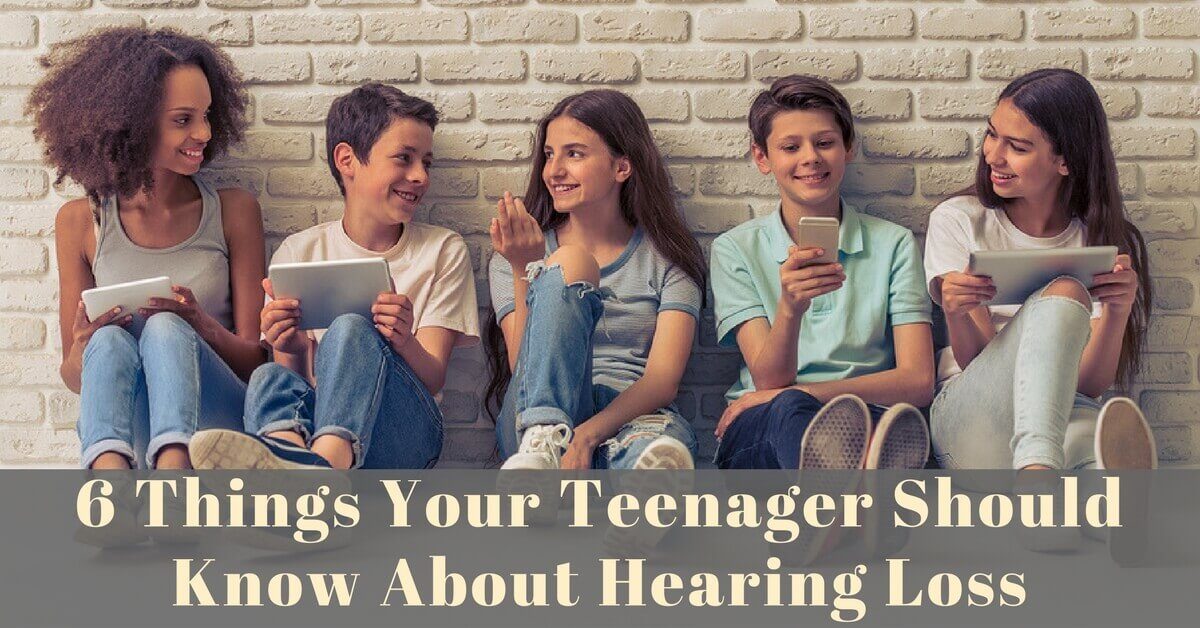Does it ever seem like your teenager has stopped listening to you? It might not be selective listening!
Recent studies on the millennial generation have shown that a large number of people in their late 20s are experiencing some degree of hearing loss, which is a break with counterparts in previous generations. With the advent of personal electronic devices and earbud headphones, most young people are plugged in and tuning out the world around them.
Young people tend to take hearing for granted, relegating troubles with hearing to a distant future. Noise-induced hearing loss is 100% preventable and there are ways for young people to save their hearing now.
Here are 6 facts about hearing loss to share with the teenagers in your life.
#1: Hearing Loss Is Irreversible
Your sense of hearing relies on small hair cells in the inner ear to transmit sounds to the brain. These tiny cells are sensitive and can easily be damaged by exposure to loud sounds. Once your inner ear cells are damaged, they do not regenerate. As such, hearing loss is irreversible and there is no cure. In other words, once it’s gone, it’s gone for good!
Hearing loss is treatable however; treatment is available in the form of hearing aids.
#2: Noise-induced hearing loss is one of the most common forms.
Noise-induced hearing loss is caused by exposure to loud sounds over long periods of time. In certain occupations such as construction, factory work, and the music industry, noise-induced hearing loss is prevalent – but it can also occur from exposure to everyday noises at unsafe volumes, such as the ones you experience through your earbuds.
#3: Earbuds increase the risk of hearing loss.
Earbuds are cool and convenient, and they give you access to your favorite movies, videos, music, and podcasts all day, everywhere you go. But did you know that they heighten the risk of damage to your hearing? Since earbuds offer almost no noise-cancellation, people tend to listen to media at higher volumes than with over-the-ear headphones. Situated in the ear canal, close to the ear drum, earbuds crank out high volumes comparable to using power tools in a coal mine.
If you’re in a noisy environment, whether it’s on a plane or on a subway train, you may have difficulty hearing through your earbuds. Rather than cranking up the volume – which compounds the level of damaging decibels – consider unplugging and waiting until you’re in a different environment to listen to your music.
Also, follow the 60-60 rule: listen to media at 60% volume for no more than 60 minutes at a time. Give your ears a break!
#4: Use technology to your advantage.
Most of your electronic devices have been designed to play at volumes much louder than recommended for hearing health. With longer battery life, these devices can play loud music for longer periods of time. This increases your exposure to dangerous levels of sound. Look for a free, downloadable app developed to manage volume levels on your devices. Set the volume at 60% or lower and stick to this level for safe listening.
#5: Hearing loss is linked with other health problems.
Hearing loss increases the risk for developing depression, anxiety, and higher levels of stress. Researchers have recently found a potential link between hearing loss and dementia. The auditory system also controls your balance; individuals with hearing loss are at higher risk for falls and accidents.
While these things may not be immediate concerns for young people, it’s important to remember that hearing loss occurs gradually, over a long period of time. In other words, you may not immediately experience the consequences of unhealthy listening practices, but you may have to deal with these issues later in your life, even as early as your 30s or 40s.
#6: Your Generation’s Hearing is Getting Worse
Speaking of growing up, researchers have found that the current generation of young people are experiencing higher loss at earlier ages. For individuals between the ages of 12 and 35, researchers found that 30% are more likely to experience hearing loss than their counterparts in the 1980s and 1990s.
According to the World Health Organization, about 1.1 billion teenagers and young adults are “at risk of developing hearing loss due to the unsafe use of personal audio devices and exposure to damaging levels of sound in noisy entertainment venues.”
When it comes to protecting your hearing, the time is now! Use earplugs (foam or silicone) when going to loud venues; for added protection, invest in a pair of custom earplugs. When listening to earbuds, make sure your volumes are at manageable levels. Even better, invest in a pair of noise-canceling headphones. They’ll probably help cancel out your parents’ nagging, too!
To learn more about hearing loss or to schedule a hearing test, contact us at Hear Care.

